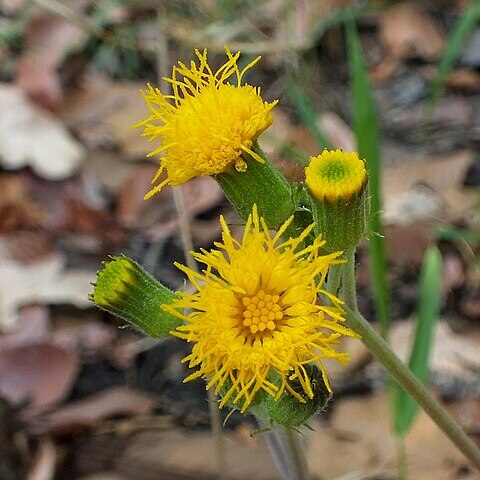Herbs, perennial, scapigerous, 20-50 cm tall, slightly fleshy. Roots globose or sometimes branched, tuberiform, (1-)2-6 cm in diam., fleshy, with many fibrous roots. Stems erect, 1-3, ascending or creeping, green or purplish, striate when dry, sparsely pubescent or glabrous. Leaves often crowded at base of stem, rosulate; petiole 0.5-3 cm, basally broad, slightly fleshy, not auriculate; blade abaxially often purplish, adaxially green, obovate, spatulate, or elliptic, rarely ovate, 5-18 × 2.5-5 cm, both surfaces sparsely shortly pubescent or ± glabrescent, lateral veins 8-20-paired, to lobes or curved before margins, inconspicuous, base gradually attenuate into petiole, margin pinnatifid, rarely dentate; lobes triangular or ovate-oblong, entire or denticulate, apex obtuse or rather acute. Median or upper leaves reduced, or with 1 or 2 leaflets, shortly petiolate or subsessile; leaflets pinnatilobed, lobes small, both surfaces pubescent. Capitula 1-5, 10-15 mm in diam., terminal, laxly corymbose; peduncles 0.5-4 cm, often with 1 or 2 linear or filiform-linear bracteoles, densely or sparsely pubescent. Involucres campanulate, 10-12 × 8-10 mm; bracts of calyculus 8 or 9, unequal, linear; phyllaries uniseriate, 13, green or purplish, linear-lanceolate or lanceolate, 7-12 × ca. 1.5 mm, conspicuously 1-3-ribbed, sparsely shortly pubescent, margin broadly scarious, apically acuminate. Florets yellow to reddish; corolla 10-13 mm, distinctly exceeding involucre, tube 7-9 mm, slender, expanded above; lobes ovate-triangular, apically obtuse. Anthers obtuse at base. Style branch tips conical, papillose. Achenes red-brown, cylindric, 3-4 mm, glabrous or puberulent, 10-ribbed. Pappus hairs numerous, white, 10-12 mm, sericeous, early deciduous. Fl. Apr-Nov. 2n = 20.
More
Perennial herb 0.4–1 m high, with unpleasant musky smell; tuberous rootstock, the tubers to 10 cm long and up to 5 cm across; stems ± fleshy, with leaves in rosette or leafy to half their length, ± pubescent.. Leaves slightly fleshy, green or purplish, the basal leaves ovate or spatulate, 4–22 cm long, 2.5–11 cm wide, attenuate into a petioloid base, margins ± entire, apex obtuse; middle and upper leaves narrower, elliptic, obovate or narrowly obovate, lobed to pinnatisect, 6–25 cm long, 2–7 cm wide, base clasping the stem in the uppermost leaves, margins 1–6-lobed, the lobes toothed or lobed; all leaves pubescent or glabrous, glandular.. Capitula terminal, 2–3 together, erect; involucre campanulate, 8–13 mm long, 13–15 mm in diameter; bracts of calyculus 1–3 mm long; phyllaries 10–16, (6–)8–13 mm long, pubescent and sometimes glandular.. Florets orange or yellow, corolla 9–12.5 mm long, expanded in upper part, lobes 0.9–1.7 mm long.. Achenes 3 mm long, pubescent or glabrous; pappus 7–11 mm long.
A herb. It is erect and keeps growing from year to year. It is a soft or succulent plant. It grows 130 cm tall. The roots are fattened with tubers. These are round or lobed and 2-6 cm across. The leaves are simple and in a ring. They can have shallow lobes. They are spoon shaped or oval and 7-40 cm long by 2-20 cm wide. The upper leaves are smaller and have more lobed. The flowers are in a head. The flower stalk is 4 cm long. They are yellow or red. The fruit is dry and 3-4 mm long.

